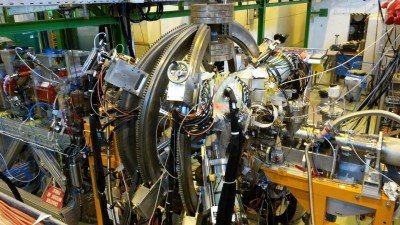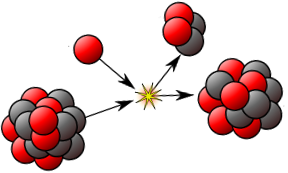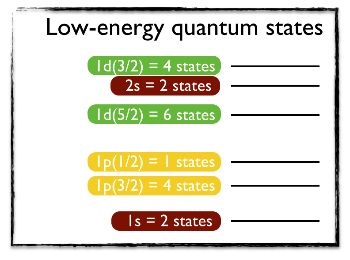Live from CERN - the magics behind the doubly-magic atomic nuclei [also in French: la magie des noyaux atomiques doublement magiques]
An atomic doubly-magic nucleus? How great does this name sound?
Doubly-magic nuclei are special and new investigations have started at CERN last week, connected to the High Intensity Energy-ISOLDE, or HIE-ISOLDE facility. I focus on this post on the theory behind these doubly-magic nuclei, the so-called shell model of the nucleus.
La version francaise de ce post est disponible ci-dessous.
 [image credits: CERN ]
[image credits: CERN ]
THE CONTEXT: NUCLEAR PHYSICS
The wording doubly-magic nucleus comes from nuclear physics, and more precisely from the shell model of the nucleus.
As already mentioned in some of my previous posts, an atom is comprised of a nucleus and electrons orbiting around this nucleus. For the topic of the day, we only focus on the nucleus, that is made of neutrons and protons.
Neutron and proton properties are generally quite close (besides their electric charge), so that these are generally considered as two different types of a more general object called a nucleon.
 [image credits: wikipedia ]
[image credits: wikipedia ]
THE SHELL MODEL IN A NUTSHELL
Different models have been proposed in order to explain the structure of the atomic nuclei. One of them has been found to work remarkably well when confronted to data and is called the shell model of the nucleus.
It succeeds in explaining all patterns observed from nuclear physics data, and in particular the remarkable magic number pattern.
In the shell model, protons are organized into proton shells and neutrons into neutron shells. Those shells are labeled by a number (1, 2, 3, …) followed by a letter (s, p, d, f, g, …). On the homemade picture below, I show the first lowest energetic shells.

The lowest-energetic shell is the 1s shell and the next one is the 1p shell that is actually split into two levels, a 1p(3/2) and a 1p(1/2) level. Then comes the 1d shell that is again split into two, with a 1d(5/2) and 1d(3/2) level. Funnily enough, the 2s level has an energy such that it lies between the two 1d levels.
It is at this stage important to note the important gap in energy between the 1s level and the two 1p levels, and between the two 1p levels and the next three levels. The entire ensemble of accessible states is actually divided into subsets of states of energies that are close, those sets being well separated in energy from each other.
Each shell contains a given number of quantum states that can be occupied by the nucleons. The numbers of states available for each level are different and indicated on the above figure for the first levels.
Moreover, the energy of the nucleus must be as small as possible. If we have Z protons and N neutrons, the Z lowest-energetic proton quantum states an the N lowest-energetic neutron quantum states are thus occupied.
MAGIC NUMBERS? DOUBLY-MAGIC NUCLEI?
Data tells us that some nuclei are more stable than others. This is particularly true for those whose numbers of neutrons N and protons Z belong to the list
2 8 20 28 50 82 126
Those are the magic numbers. A magic nucleus has either a magic number of protons or a magic number of neutrons, where a doubly-magic nucleus have both a magic number of protons and a magic number of neutrons. These doubly-magic nuclei are found especially stable.
For instance, there are two doubly-magic Calcium isotopes with both 20 protons, and respectively 28 or 20 neutrons. Oxygen-16 (8 neutrons and 8 protons), Helium-4 (2 neutrons and 2 protons), Lead-208 (82 protons and 126 neutrons, the heaviest stable nucleus) are all doubly-magic and stable.
The properties of these doubly magic nucleus are amazing: there are more abundant in nature (Helium-4 is the most abundant nucleus in the universe), a much larger energy must be provided to excite them or to extract a neutron from them, etc.
WHY ARE 2, 8, 20, 28, 50, 82 AND 126 ALL MAGIC NUMBERS?
 [image credits: pixabay ]
[image credits: pixabay ]
As discussed above, subsets of energy levels of the shell model of the nucleus are grouped together, and there are energy gaps separating the different subsets of levels. Let us now do some counting of the number of quantum states in each subset, on the basis of the above picture.
- Level 1s: two states and we get the first magic number;
- Levels 1s and 1p: two quantum states for the 1s level, four states in the 1p(3/2) level and two states in the 1p(1/2) level. The total consists thus of eight states, which is the second magic number;
- And so on.
These configurations where a group of levels that are close in energy is entirely occupied by nucleons turn to be super stable. The binding energy per nucleon in the corresponding nuclei is always found larger than expected, and it is very hard to extract a neutron or a proton from the nucleus.
THE HIE-ISOLDE FACILITY AT CERN
 [image credits: CERN ]
[image credits: CERN ]
The ISOLDE facility at CERN, or its High Intensity-Energy version HIE-ISOLDE, is a nuclear physics research facility aiming to study the properties of various atomic nuclei.
It is a source of beams of radioactive nuclei with either too many or too few neutrons to be stable. The beams are obtained from the bombardment of different targets with protons. The atomic fragments resulting from the bombardment are then collected, separated according to their mass and studied.
ISOLDE has managed to generate more than 700 isotopes for more than 70 elements so far, and some of the experiments around ISOLDE are naturally focusing on the study of doubly-magic nuclei and their properties. But not only on stable doubly-magic nuclei.
Unstable doubly-magic nuclei exist when the numbers of protons and neutrons are such that the nucleus has no other option than quickly decaying. This decay is however found to be slower than for nuclei with similar numbers of protons and neutrons that are non-magical.
For instance, the Calcium-52 (20 protons and 32 neutrons) has been studied in the past and the new experiments will focus on the Tin-100 (50 protons and 50 neutrons) and Tin-132 (50 protons and 82 neutrons) nuclei, two unstable doubly-magic nuclei.
The Tin-100 and Tin-132 nuclei are unstable because they contain too many neutrons with respect to their number of protons, but their magical properties makes them less unstable that nuclei that are similar in terms of their number of nucleons. The study of their properties could hence make us get new knowledge about nuclear physics.
Un noyau atomique doublement magique ? Un nom sympa en tous cas, n’est-ce pas ?
Ces noyaux doublement magiques sont speciaux, et une nouvelle serie d’etudes ont demarre au CERN la semaine derniere aupres du complexe experimental High Intensity Energy-ISOLDE (ou HIE-ISOLDE). Dans ce post, je me concentre sur les aspects theoriques associes a ces noyaux doublement magiques, et sur le modele en couches du noyau.
 [image credits: CERN ]
[image credits: CERN ]
LE CONTEXTE: LA PHYSIQUE NUCLEAIRE
L’idiome noyau doublement magique vient de la physique nucleaire, et plus particulierement du modele en couches du noyau.
Comme deja mentionne dans plusieurs de mes posts precedents, un atome est compris d’un noyau et d’electrons orbitant autour de ce noyau. Aujourd’hui, nous allons nous concentrer sur le noyau uniquement, qui est constitue de neutrons et de protons.
Les proprietes des neutrons et des protons sont en general assez semblables (mis a part leur charge electrique) de sorte qu’ils sont generalement consideres comme deux facettes d’un meme objet appele un nucleon.
 [image credits: wikipedia ]
[image credits: wikipedia ]
LE MODELE EN COUCHES EN UN MOT (OU PLUS)
Differents modeles ont ete proposes pour expliquer la structure des noyaux atomiques. L’un d’entre eux a montre un accord remarquable avec les donnees de physique nucleaire et se nomme le modele en couches du nucleon.
Il reproduit avec sucess differents patterns observes dans les donnees de physique nucleaire, et il fournit en particulier une explictation aux nombres magiques.
Dans le modele en couches, les protons sont organises en couches de protons et les neutrons en couches de neutrons. Chaque couche est numerotee par un chiffre (1, 2, 3, …) suivi d’une lettre (s, p, d, f, g, …). Sur la figure ci-dessous (c’est du fait maison), j’ai represente les premieres couches dont l’energie correspondante est la plus basse.

La couche de plus basse energie est la couche 1s, suivi de la couche 1p qui est divisee en deux niveaux, un niveau 1p(3/2) et un niveau 1p(1/2). Nous avons ensuite la couche 1d qui est a nouveau divisee en deux avec un niveau 1d(5/2) et un niveau 1d(3/2). De facon assez surprenante, nous avons la couche 2s qui a une energie telle qu’elle se trouve entre les deux niveaux de type 1d.
Il faut remarquer a ce stade l’important saut en energie entre le niveau 1s et les deux niveaux 1p, ainsi qu’entre les deux niveaux 1p et les trois niveaux suivants. L’ensemble des niveaux accessibles est en fait divise en sous-ensembles de paquets de niveaux, et chacun de ces sous-ensembles est bien separe en energie des autres.
Chaque couche contient un certain nombre d’etats quantiques qui peuvent potentiellement etre occupes par les nucleons. Le nombre d’etats disponible pour chaque niveau est different, et indique sur la figure ci-dessus pour les premiers niveaux.
De plus, l’energie des nucleons doit etre aussi petite que possible. Ainsi, si nous avons Z protons et N neutrons, les Z etats quantiques de type proton d’energies les plus basses seront occupes, tout comme les N etats quantiques de type neutron et d’energies les plus basses.
LES NOMBRES MAGIQUES ? LES NOYAUX DOUBLEMENT MAGIQUES ?
Les donnes nous indiquent que plusieurs noyaux sont beaucoup plus stables que les autres. C’est vrai en particulier lorsque leurs nombres Z et N en protons en neutrons appartiennent a la liste
2 8 20 28 50 82 126
Ce sont les nombres magiques. Un noyau magique aura un nombre de magique de protons ou un nombre magique de neutrons, tandis qu’un noyau doublement magique aura a la fois un nombre magique de protons et de neutrons. Ces noyaux doublement magiques sont ainsi particulierement stables.
Par exemple, deux isotopes du Calcium sont doublement magiques, avec 20 protons chacun et respectivement 20 et 28 neutrons. L’Oxyegene-16 (8 neutrons et 8 protons), l’Helium-4 (2 neutrons et 2 protons) et le Plomb-208 (82 protons et 126 neutrons, le plus lourd des noyaux stables) sont tous doublement magiques et stables.
Les proprietes de ces noyaux doublement magiques sont surprenantes: ils sont plus abondants dans la nature (l’Helium-4 est le noyaux le plus abondant de l’univers), il faut fournir plus d’energie pour les exciter ou leur arracher un neutron, etc.
POURQUOI LES NOMBRES 2, 8, 20, 28, 50, 82 ET 126 SONT-ILS MAGIQUES?
 [image credits: pixabay ]
[image credits: pixabay ]
Comme discute ci-dessus, les niveaux d’energie du modele en couches sont groupes en paquets de niveaux bien separes en energie les uns des autres. Effectuons un petit exercice de comptage du nombres d’etats quantiques dans chaque paquet a partir de la figure ci-dessus:
- Niveau 1s: deux etats quantiques en tous, et nous obtenons le premier nombre magique;
- Niveaux 1s et 1p: nous avons deux etats quantiques pour le niveau 1s, 4 etats pour le niveau 1p(3/2) et deux etats pour le niveau 1p(1/2). Le total est donc huit, ou le second nombre magique;
- Et ainsi de suite.
Les configurations dans lesquelles un groupe de niveaux d’energie proche est entierement occupe par des nucleons sont observees comme extremement stables. L’energie de liaison par nucleon dans le noyau est superieure aux attentes naives, et il est tres dur d’extraire un neutron ou un proton de ces noyaux.
LE COMPLEXE HIE-ISOLDE AU CERN
 [image credits: CERN ]
[image credits: CERN ]
Le complexe ISOLDE au CERN, ou sa version a haute energie et intensite HIE-ISOLDE, est un complexe de recherche en physique nucleaire ayant pour but l’etude des proprietes de differents noyaux atomiques.
Il s’agit d’une source de faisceau de noyaux radioactifs comportant soit trop de neutrons soit trop de protons pour etre stables qui est obtenue a partir de bombardements par des protons de differentes cibles. Les fragments atomiques resultant du bombardement sont alors collectes, separes en fonction de leur masse et etudies.
ISOLDE a ainsi reussi a generer au jour d’aujourd’hui plus de 700 isotopes de plus de 70 elements . Plusieurs experiences autour d’ISOLDE se concentrent naturellement sur l’etude des noyaux doublement magique et de leurs proprietes, et pas seulement sur les noyaux stables.
Des noyaux instables doublement magiques existent lorsque les nombres de protons et de neutrons sont tels que le noyau se desintegre rapidement. Cette desintegration est cependant moins rapides que pour les noyaux au nombres de protons et neutrons similaires mais non magiques.
Par exemple, le Calcium-52 (20 protons et 32 neutrons) a ete etudie dans le passe et de nouvelles experiences vont se concentrer sur l’Etain-100 (50 protons et 50 neutrons) et l’Etain-132 (50 protons et 82 neutrons), deux noyaux doublements magiques instables..
Les noyaux d’Etain-100 et d’Etain-132 sont instables car ils contiennent beaucoup trop de neutrons par rapport au nombre de proton. Leurs proprietes magiques font qu’ils sont alors moins stables que d’autres noyaux similaires en nombre de nucleons, et qu’ils peuvent alors etre etudies pour apprendre plus du monde de la physique nucleaire.
I call it it "The Large Hardon Collider" because if anything can make a stiffie on state financed scientists, it is huge amounts of other peoples money to finance their hobby of researching things that nobody else cares for.
I do not understand your answer. It is totally off-topic. I am not discussing the LHC at all. Mostly physics. Have you really read the post?!
Now coming to your point, the amount of money invested at the level of CERN is not huge, especially when you normalize it in terms of all contributing countries' budget. The CERN budget is at the end of the day a small percent of any state budget. And what is sent back to the society is not negligible and even larger than the investment. Check this for more information.
Finally, saying that nobody cares is wrong. You may not care about. Don't generalize. In addition, one may not see any application of the current research today, but what about tomorrow or after tomorrow. Let me recall you that without physics: no World Wide Web, no GPS, no hadrotherapy, etc. Think about it.
And even if there is no discovery today, check my post above and you will see that there is a gain for the society. It is not a loss.
Yeah whatever they are called those different accelerators. I just like the wordplay of it :-) ... I do not care if a budget is large or small, if it is funded with stolen money, from defenseless people who would rather spend their own money on their children´s summer vacation, than some parasitical state-educated state-funded geek hobby that brings nothing of value to the real world. Who cares if there is a Higgs bozo or not or if there are eleven string dimensions - if no scientist is able to determine if taxation is theft. No one knows if research is valuable if everyone is forced to pay for it. If I buy an antique thing for 100 dollars and resell it for 80 dollars, have I created 80 dollars worth of value ? ... NO, i have squandered 20 dollars of value
This is your opinion. Who cares about it? (I can answer exactly the same thing as you did). I can cite you a lot of people who have interests in science and knowledge. Knowing how the universe works is amazing, no matter 'you' find it boring or not. You also seem to forget that without knowledge and scientific development, it is a bit a way back to the trees.
Now concerning CERN, you exaggerate, as the amount of money returned to the society is positive and not negative (have you only clicked on the link of the post I as referring to?). So that your 80/100 USD comparison is not appropriate.
You do not seem to care at all about (fundamental) science, and for some reason you don't want to see fundamental science funded. Probably because whatever are the results, they will not directly improve your personal life? Fair enough. By the way, this is exactly the topic of the post I referred before.
No matter what I will say, this conversation leads to nowhere. So lets stop it here and spare our respective time.
And now i learnt a few scientific words in french!
oh man...
would love for the conspiracy theorist to crawl out and pose their theories for a good debunking. recall a year ago seeing all those silly videos on YouTube claiming CERN was some big evil illuminati project to tear open a black hole that demons and shit would creep in from other galaxies, complete with their questioning of the Shiva dances and all that jazz...
I totally don't understand the physics of all this - though would be very interested to see such of those conspiracy theories put to the grave with a proper perspective from those fully-involved in CERN. :-)
IMO, you will never be able to put them to the grave since at some point, they usually stop using scientific arguments and make ad hominem attacks...
I would love too however. ^^
Comments: This was a great post. I don't recall having learned about there being two separate P-orbital energy states. We always in chemistry classes at least lumped them together as one. I also didn't know the source of how the magic numbers were determined. I knew about them and nuclear stability when nucleon numbers are equivalent but didn't know that they came from summing the number of nucleons equivalent to electrons present in the various energy shells. Learned quite a bit here!
Corrections: "Helium-4 is the must abundant nucleus in the universe" must should be most.
The separation of the P-wave comes from spin-orbit effects. As for any level different from a s-level whose orbital quantum number vanishes.
Concerning the orbit stuff, you may want to see the model as neutrons and protons orbiting around the center of the nucleus. Thanks to Pauli exclusion principle, they will never collider (as all the lowest energy levels are taken, there is no way for them to jump to another state without an external source of energy).
PS: thanks for the typo ;)
is there a standard duration/deadline for studying nuclei like Tin-100 and Tin-132?
The lifetime is of about 1 second and 40 seconds, respectively. There is thus time for studying them once produced.